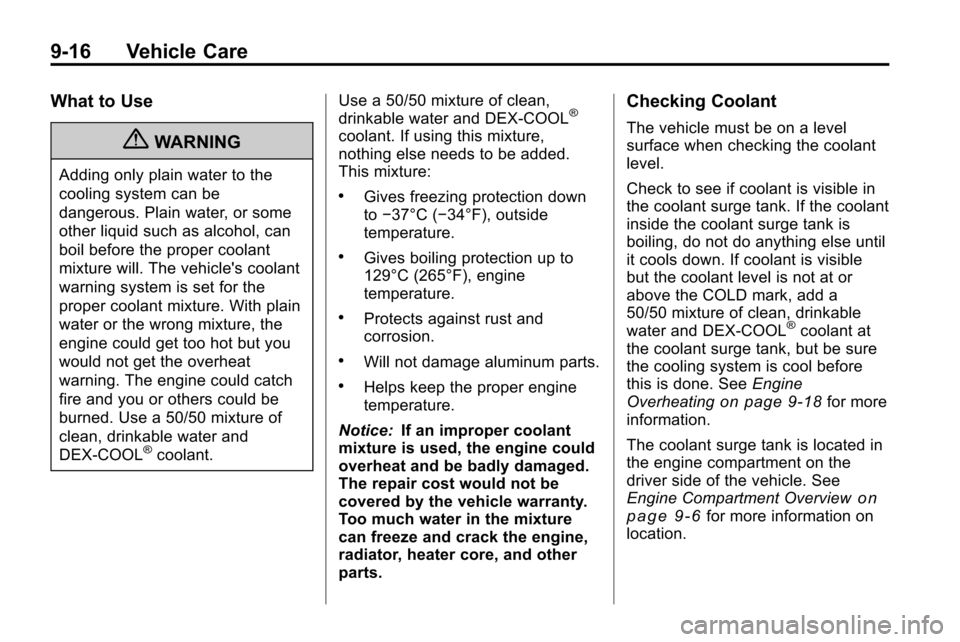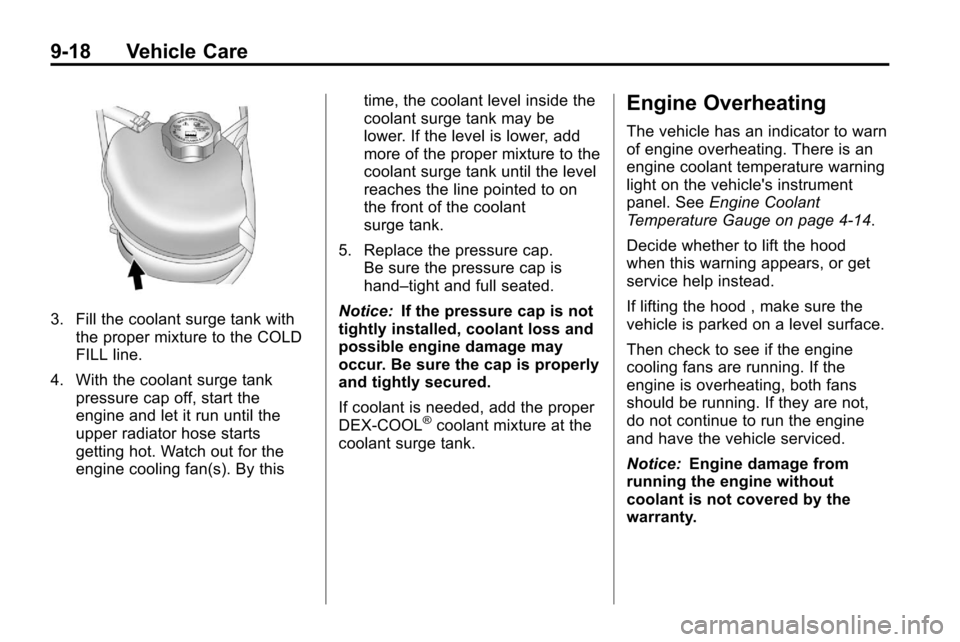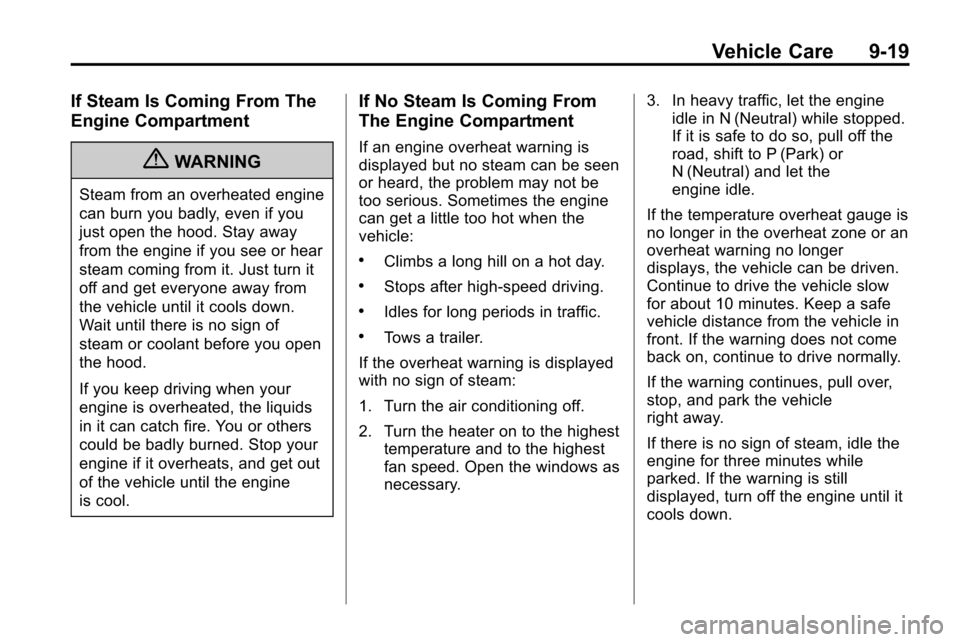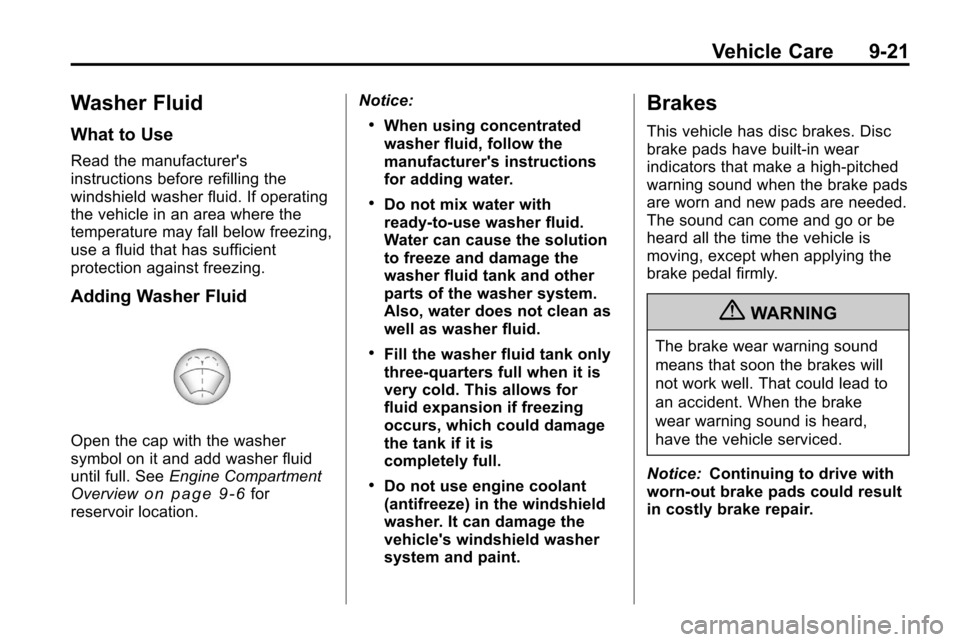2010 CHEVROLET EQUINOX coolant temperature
[x] Cancel search: coolant temperaturePage 284 of 394

9-16 Vehicle Care
What to Use
{WARNING
Adding only plain water to the
cooling system can be
dangerous. Plain water, or some
other liquid such as alcohol, can
boil before the proper coolant
mixture will. The vehicle's coolant
warning system is set for the
proper coolant mixture. With plain
water or the wrong mixture, the
engine could get too hot but you
would not get the overheat
warning. The engine could catch
fire and you or others could be
burned. Use a 50/50 mixture of
clean, drinkable water and
DEX-COOL
®coolant.Use a 50/50 mixture of clean,
drinkable water and DEX-COOL
®
coolant. If using this mixture,
nothing else needs to be added.
This mixture:
.Gives freezing protection down
to
−37°C (−34°F), outside
temperature.
.Gives boiling protection up to
129°C (265°F), engine
temperature.
.Protects against rust and
corrosion.
.Will not damage aluminum parts.
.Helps keep the proper engine
temperature.
Notice: If an improper coolant
mixture is used, the engine could
overheat and be badly damaged.
The repair cost would not be
covered by the vehicle warranty.
Too much water in the mixture
can freeze and crack the engine,
radiator, heater core, and other
parts.
Checking Coolant
The vehicle must be on a level
surface when checking the coolant
level.
Check to see if coolant is visible in
the coolant surge tank. If the coolant
inside the coolant surge tank is
boiling, do not do anything else until
it cools down. If coolant is visible
but the coolant level is not at or
above the COLD mark, add a
50/50 mixture of clean, drinkable
water and DEX-COOL
®coolant at
the coolant surge tank, but be sure
the cooling system is cool before
this is done. See Engine
Overheating
on page 9‑18for more
information.
The coolant surge tank is located in
the engine compartment on the
driver side of the vehicle. See
Engine Compartment Overview
on
page 9‑6for more information on
location.
Page 286 of 394

9-18 Vehicle Care
3. Fill the coolant surge tank withthe proper mixture to the COLD
FILL line.
4. With the coolant surge tank pressure cap off, start the
engine and let it run until the
upper radiator hose starts
getting hot. Watch out for the
engine cooling fan(s). By this time, the coolant level inside the
coolant surge tank may be
lower. If the level is lower, add
more of the proper mixture to the
coolant surge tank until the level
reaches the line pointed to on
the front of the coolant
surge tank.
5. Replace the pressure cap. Be sure the pressure cap is
hand–tight and full seated.
Notice: If the pressure cap is not
tightly installed, coolant loss and
possible engine damage may
occur. Be sure the cap is properly
and tightly secured.
If coolant is needed, add the proper
DEX-COOL
®coolant mixture at the
coolant surge tank.
Engine Overheating
The vehicle has an indicator to warn
of engine overheating. There is an
engine coolant temperature warning
light on the vehicle's instrument
panel. See Engine Coolant
Temperature Gauge on page 4‑14.
Decide whether to lift the hood
when this warning appears, or get
service help instead.
If lifting the hood , make sure the
vehicle is parked on a level surface.
Then check to see if the engine
cooling fans are running. If the
engine is overheating, both fans
should be running. If they are not,
do not continue to run the engine
and have the vehicle serviced.
Notice: Engine damage from
running the engine without
coolant is not covered by the
warranty.
Page 287 of 394

Vehicle Care 9-19
If Steam Is Coming From The
Engine Compartment
{WARNING
Steam from an overheated engine
can burn you badly, even if you
just open the hood. Stay away
from the engine if you see or hear
steam coming from it. Just turn it
off and get everyone away from
the vehicle until it cools down.
Wait until there is no sign of
steam or coolant before you open
the hood.
If you keep driving when your
engine is overheated, the liquids
in it can catch fire. You or others
could be badly burned. Stop your
engine if it overheats, and get out
of the vehicle until the engine
is cool.
If No Steam Is Coming From
The Engine Compartment
If an engine overheat warning is
displayed but no steam can be seen
or heard, the problem may not be
too serious. Sometimes the engine
can get a little too hot when the
vehicle:
.Climbs a long hill on a hot day.
.Stops after high-speed driving.
.Idles for long periods in traffic.
.Tows a trailer.
If the overheat warning is displayed
with no sign of steam:
1. Turn the air conditioning off.
2. Turn the heater on to the highest temperature and to the highest
fan speed. Open the windows as
necessary. 3. In heavy traffic, let the engine
idle in N (Neutral) while stopped.
If it is safe to do so, pull off the
road, shift to P (Park) or
N (Neutral) and let the
engine idle.
If the temperature overheat gauge is
no longer in the overheat zone or an
overheat warning no longer
displays, the vehicle can be driven.
Continue to drive the vehicle slow
for about 10 minutes. Keep a safe
vehicle distance from the vehicle in
front. If the warning does not come
back on, continue to drive normally.
If the warning continues, pull over,
stop, and park the vehicle
right away.
If there is no sign of steam, idle the
engine for three minutes while
parked. If the warning is still
displayed, turn off the engine until it
cools down.
Page 289 of 394

Vehicle Care 9-21
Washer Fluid
What to Use
Read the manufacturer's
instructions before refilling the
windshield washer fluid. If operating
the vehicle in an area where the
temperature may fall below freezing,
use a fluid that has sufficient
protection against freezing.
Adding Washer Fluid
Open the cap with the washer
symbol on it and add washer fluid
until full. SeeEngine Compartment
Overview
on page 9‑6for
reservoir location. Notice:
.When using concentrated
washer fluid, follow the
manufacturer's instructions
for adding water.
.Do not mix water with
ready-to-use washer fluid.
Water can cause the solution
to freeze and damage the
washer fluid tank and other
parts of the washer system.
Also, water does not clean as
well as washer fluid.
.Fill the washer fluid tank only
three-quarters full when it is
very cold. This allows for
fluid expansion if freezing
occurs, which could damage
the tank if it is
completely full.
.Do not use engine coolant
(antifreeze) in the windshield
washer. It can damage the
vehicle's windshield washer
system and paint.
Brakes
This vehicle has disc brakes. Disc
brake pads have built-in wear
indicators that make a high-pitched
warning sound when the brake pads
are worn and new pads are needed.
The sound can come and go or be
heard all the time the vehicle is
moving, except when applying the
brake pedal firmly.
{WARNING
The brake wear warning sound
means that soon the brakes will
not work well. That could lead to
an accident. When the brake
wear warning sound is heard,
have the vehicle serviced.
Notice: Continuing to drive with
worn-out brake pads could result
in costly brake repair.
Page 385 of 394

INDEX i-3
CleaningExterior Care . . . . . . . . . . . . . . . . . 9-75
Interior Care . . . . . . . . . . . . . . . . . . 9-79
Climate Control Systems . . . . . . . 7-1 Automatic . . . . . . . . . . . . . . . . . . . . . . 7-3
Clock . . . . . . . . . . . . . . . . . . . . . 4-9, 4-10
Cluster, IP . . . . . . . . . . . . . . . . . . . . . 4-12
Collision Damage Repair . . . . . 12-10
Compact Spare Tire . . . . . . . . . . . 9-68
Compass . . . . . . . . . . . . . . . . . . . . . . . 4-8
Compass Messages . . . . . . . . . . . 4-28
Control of a Vehicle . . . . . . . . . . . . . 8-4
Convenience Net . . . . . . . . . . . . . . . 3-1
Convex Mirrors . . . . . . . . . . . . . . . . 1-14
Coolant Engine . . . . . . . . . . . . . . . . . . . . . . . . 9-15
Engine Temperature
Gauge . . . . . . . . . . . . . . . . . . . . . . 4-14
Cooling System . . . . . . . . . . . . . . . . 9-14 Engine Messages . . . . . . . . . . . . 4-29
Courtesy Transportation
Program . . . . . . . . . . . . . . . . . . . . . . 12-8
Covers Cargo . . . . . . . . . . . . . . . . . . . . . . . . . . 3-1
Engine . . . . . . . . . . . . . . . . . . . . . . . . . 9-9 Cruise Control . . . . . . . . . . . . . . . . . 8-44
Light . . . . . . . . . . . . . . . . . . . . . . . . . . 4-24
Messages . . . . . . . . . . . . . . . . . . . . 4-28
Cupholders . . . . . . . . . . . . . . . . . . . . . 3-1
Customer Assistance . . . . . . . . . . 12-4 Offices . . . . . . . . . . . . . . . . . . . . . . . . 12-3
Text Telephone (TTY)Users . . . . . . . . . . . . . . . . . . . . . . . 12-4
Customer Information Service PublicationsOrdering Information . . . . . . 12-12
Customer Satisfaction Procedure . . . . . . . . . . . . . . . . . . . . 12-1
D
Damage Repair, Collision . . . . . 12-10
Danger, Warnings, andCautions . . . . . . . . . . . . . . . . . . . . . . . . iv
Data Recorders, Event . . . . . . . 12-15
Daytime Running Lamps (DRL) . . . . . . . . . . . . . . . . . . 5-2
Defensive Driving . . . . . . . . . . . . . . . 8-3
Devices, Auxiliary . . . . . . . 6-28, 6-31
Dome Lamps . . . . . . . . . . . . . . . . . . . 5-4 Door
Ajar Messages . . . . . . . . . . . . . . . 4-29
Locks . . . . . . . . . . . . . . . . . . . . . . . . . . 1-6
Power Locks . . . . . . . . . . . . . . . . . . . 1-7
Drive Systems All-Wheel Drive . . . . . . . . . 8-38, 9-24
Driver Information
Center (DIC) . . . . . . . . . . . . . . . . . 4-24
Driving Better Fuel Economy . . . . . . . . . . 8-2
Characteristics andTowing Tips . . . . . . . . . . . . . . . . . 8-58
Defensive . . . . . . . . . . . . . . . . . . . . . . 8-3
Drunk . . . . . . . . . . . . . . . . . . . . . . . . . . 8-3
Highway Hypnosis . . . . . . . . . . . . 8-20
Hill and Mountain Roads . . . . . . 8-20
If the Vehicle is Stuck . . . . . . . . . 8-23
Loss of Control . . . . . . . . . . . . . . . . 8-7
Off-Road . . . . . . . . . . . . . . . . . . . . . . 8-8
Off-Road Recovery . . . . . . . . . . . . 8-6
Vehicle Load Limits . . . . . . . . . . . 8-24
Winter . . . . . . . . . . . . . . . . . . . . . . . . 8-21
Page 386 of 394

i-4 INDEX
DVDRear Seat Entertainment
System . . . . . . . . . . . . . . . . . . . . . . 6-33
DVD/CD Player . . . . . . . . . . . . . . . . 6-21
E
ECO Button . . . . . . . . . . . . . . . . . . . 8-37
Economy Mode Fuel . . . . . . . . . . . . . . . . . . . . . . . . . . 8-37
Electrical Equipment, Add-On . . . . . . . . . . . . . . . . . . . . . . 8-64
Electrical System Engine Compartment Fuse
Block . . . . . . . . . . . . . . . . . . . . . . . . 9-34
Fuses . . . . . . . . . . . . . . . . . . . . . . . . 9-34
Instrument Panel Fuse Block . . . . . . . . . . . . . . . . . . . . . . . . 9-37
Engine
Air Cleaner/Filter . . . . . . . . . . . . . 9-13
Check and Service EngineSoon Light . . . . . . . . . . . . . . . . . . 4-16
Compartment Overview . . . . . . . . 9-6
Coolant . . . . . . . . . . . . . . . . . . . . . . . 9-15 Engine (cont.)
Coolant Heater . . . . . . . . . . . . . . . 8-31
Coolant Temperature
Gauge . . . . . . . . . . . . . . . . . . . . . . 4-14
Cooling System . . . . . . . . . . . . . . . 9-14
Cooling System Messages . . . 4-29
Cover . . . . . . . . . . . . . . . . . . . . . . . . . . 9-9
Drive Belt Routing . . . . . . . . . . . . 11-4
Exhaust . . . . . . . . . . . . . . . . . . . . . . 8-34
Overheating . . . . . . . . . . . . . . . . . . 9-18
Power Messages . . . . . . . . . . . . . 4-30
Pressure Light . . . . . . . . . . . . . . . . 4-22
Running While Parked . . . . . . . . 8-34
Starting . . . . . . . . . . . . . . . . . . . . . . . 8-30
Engine Oil Life System . . . . . . . . . . . . . . . . . . . 9-11
Messages . . . . . . . . . . . . . . . . . . . . 4-30
Entry Lighting . . . . . . . . . . . . . . . . . . . 5-4
Equipment, Towing . . . . . . . . . . . . 8-63
Event Data Recorders . . . . . . . . 12-15
Extender, Safety Belt . . . . . . . . . . 2-21
Exterior Lamp Controls . . . . . . . . . 5-1
F
Filter
Engine Air Cleaner . . . . . . . . . . . 9-13
Flash-to-Pass . . . . . . . . . . . . . . . . . . . 5-2
Flashers, Hazard Warning . . . . . . 5-2
Flat Tire . . . . . . . . . . . . . . . . . . . . . . . 9-59
Flat Tire, Changing . . . . . . . . . . . . 9-61
Fluid Automatic Transmission . . . . . . 9-12
Brakes . . . . . . . . . . . . . . . . . . . . . . . . 9-22
Power Steering . . . . . . . . . . . . . . . 9-20
Washer . . . . . . . . . . . . . . . . . . . . . . . 9-21
Fog Lamps Bulb Replacement . . . . . . . 5-3, 9-31
Light . . . . . . . . . . . . . . . . . . . . . . . . . . 4-23
Front Seats
Adjustment . . . . . . . . . . . . . . . . . . . . 2-3
Heated . . . . . . . . . . . . . . . . . . . . . . . . 2-7
Fuel . . . . . . . . . . . . . . . . . . . . . . . . . . . 8-53 Additives . . . . . . . . . . . . . . . . . . . . . 8-55
Economy Driving . . . . . . . . . . . . . . 8-2
Economy Light . . . . . . . . . . . . . . . 4-22
Filling a Portable Fuel
Container . . . . . . . . . . . . . . . . . . . 8-57
Filling the Tank . . . . . . . . . . . . . . . 8-56
Fuels in Foreign Countries . . . . 8-54
Page 387 of 394

INDEX i-5
Fuel (cont.)Gasoline Specifications . . . . . . . 8-54
Gauge . . . . . . . . . . . . . . . . . . . . . . . . 4-13
Low Fuel Warning Light . . . . . . . 4-22
Recommended . . . . . . . . . . . . . . . 8-54
Requirements, California . . . . . 8-54
System Messages . . . . . . . . . . . . 4-30
Fuel Economy Mode . . . . . . . . . . . 8-37
Fuses . . . . . . . . . . . . . . . . . . . . . . . . . 9-34 Engine Compartment FuseBlock . . . . . . . . . . . . . . . . . . . . . . . . 9-34
Instrument Panel Fuse Block . . . . . . . . . . . . . . . . . . . . . . . . 9-37
G
GasolineSpecifications . . . . . . . . . . . . . . . . . 8-54
Gauges Engine CoolantTemperature . . . . . . . . . . . . . . . . 4-14
Fuel . . . . . . . . . . . . . . . . . . . . . . . . . . 4-13
Odometer . . . . . . . . . . . . . . . . . . . . . 4-13
Speedometer . . . . . . . . . . . . . . . . . 4-13
Tachometer . . . . . . . . . . . . . . . . . . . 4-13
Warning Lights and Indicators . . . . . . . . . . . . . . . . . . . 4-11 General Information
Service and Maintenance . . . . . 10-1
Towing . . . . . . . . . . . . . . . . . . . . . . . . 8-57
Vehicle Care . . . . . . . . . . . . . . . . . . . 9-3
Glove Box . . . . . . . . . . . . . . . . . . . . . . 3-1
GM Mobility Reimbursement Program . . . . . . . . . . . . . . . . . . . . . . 12-5
H
Hazard Warning Flashers . . . . . . . 5-2
Head Restraints . . . . . . . . . . . . . . . . 2-2
HeadlampsAiming . . . . . . . . . . . . . . . . . . . . . . . . 9-27
Bulb Replacement . . . . . . . . . . . . 9-30
Daytime Running
Lamps (DRL) . . . . . . . . . . . . . . . . . 5-2
Flash-to-Pass . . . . . . . . . . . . . . . . . . 5-2
Headlamps, Front Turn Signal, Sidemarker, and
Parking Lamps . . . . . . . . . . . . . . 9-30
High-Beam On Light . . . . . . . . . . 4-23
High/Low Beam Changer . . . . . . 5-1
Lamps On Reminder . . . . . . . . . 4-23
Heated Front Seats . . . . . . . . . . . . . 2-7
Heated Mirrors . . . . . . . . . . . . . . . . . 1-14 Heater
Engine Coolant . . . . . . . . . . . . . . . 8-31
High-Beam On Light . . . . . . . . . . . 4-23
Highway Hypnosis . . . . . . . . . . . . . 8-20
Hill and Mountain Roads . . . . . . . 8-20
Hill Start Assist (HSA) . . . . . . . . . 8-41
Hood . . . . . . . . . . . . . . . . . . . . . . . . . . . 9-5
Horn . . . . . . . . . . . . . . . . . . . . . . . . . . . . 4-7
How to Wear Safety Belts Properly . . . . . . . . . . . . . . . . . . . . . . 2-12
I
Ignition Positions . . . . . . . . . . . . . . 8-28
Ignition Transmission LockCheck . . . . . . . . . . . . . . . . . . . . . . . . 9-25
Immobilizer . . . . . . . . . . . . . . . . . . . . 1-13
Infants and Young Children, Restraints . . . . . . . . . . . . . . . . . . . . 2-39
Instrument Cluster . . . . . . . . . . . . . 4-12
Instrument Panel Storage Area . . . . . . . . . . . . . . . . . . 3-1
Instrument Panel Overview . . . . . 4-4
Introduction . . . . . . . . . . . . . . . . . . .iii, 6-1